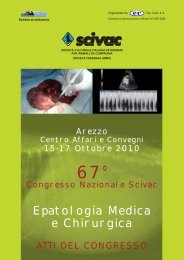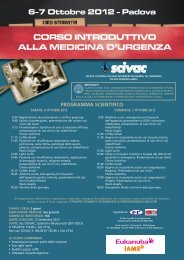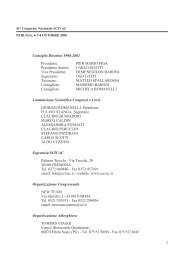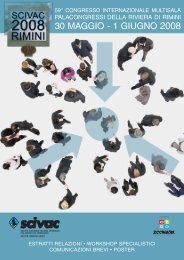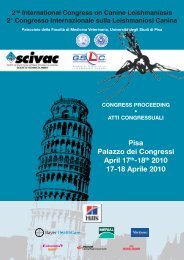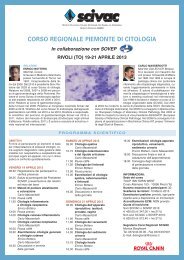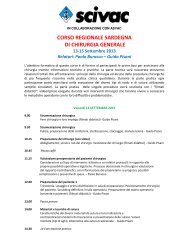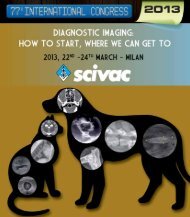58° Congresso Nazionale SCIVAC: Oncologia veterinaria
58° Congresso Nazionale SCIVAC: Oncologia veterinaria
58° Congresso Nazionale SCIVAC: Oncologia veterinaria
You also want an ePaper? Increase the reach of your titles
YUMPU automatically turns print PDFs into web optimized ePapers that Google loves.
58° <strong>Congresso</strong> <strong>Nazionale</strong> <strong>SCIVAC</strong> • Milano, 7-9 Marzo 2008 • <strong>Oncologia</strong> <strong>veterinaria</strong> - Alle soglie del III Millennio<br />
clearly differentiated chordoma from chondrosarcoma. A diagnosis of chondroid<br />
chordoma was made. No recurrence of the tumour was present 5 months<br />
after surgery.<br />
Discussion. Chordoma is an uncommon neoplasm arising from remnants of<br />
notochord. The notochord defines the cranial-caudal axis of the embryo, induces<br />
the formation of the head and central nervous system and serves as an<br />
organizing development centre of the vertebral bodies and the basal portions<br />
of the sphenoid and occipital bones. The nucleus pulposus is believed to be<br />
the only derivative of notochordal tissue. Three distinct types are recognized<br />
in human beings: 1) the classic chordoma, 2) chondroid chordoma, and 3)<br />
chordoma with a malignant spindle cell component. The classic chordoma is<br />
a slow-growing, locally aggressive neoplasm with high rate of recurrence,<br />
particularly those of sacrococcygeal or vertebral origin, while chondroid<br />
chordoma arises primarily in the spheno-occipital region and is characterized<br />
by chondromatous and chordomatous features, showing a better prognosis<br />
compared to classic chordoma (Unni and Inwards 2000). Besides human<br />
being, chondroid chordoma has been reported in rats, minks and ferrets (Dunn<br />
et al., 1991), and is frequently located on the tail. Only one case of cervical<br />
non cartilaginous chordoma with metastasis to prescapular lymph nodes was<br />
reported in the cat (Carpenter et al., 1990). The feline case reported here<br />
shows histological characteristics similar to those of the chondroid chordoma<br />
described in ferret. It may be the greater degree of differentiation that accounts<br />
for its better prognosis when compared with classic chordoma. Only<br />
an accurate histological and immunohistochemical diagnostic approach allows<br />
a proper distinction of chondroid chordoma from other tumours of the<br />
tail with cartilaginous differentiation.<br />
References<br />
1. Dunn DG, Harris RK, Meis JM, Sweet DE 1991 A histomorphologic and immunohistochemical<br />
study of chordoma in twenty ferrets (Mustela putorius furo). Vet Pathol 28: 467-473.<br />
2. Carpenter JL, Stein BS, King NW Jr, Dayal YD, Moore FM 1990 Chordoma in a cat. J Am Vet Med<br />
Assoc 197: 240-242.<br />
3. Unni KK, Inwards CY 2000 Tumors of the osteoarticular system. In Fletcher CDM Ed. Diagnostic<br />
Histopathology of Tumors, 2nd ed., pp. 1584-1585. Churchill Livingstone, London.<br />
Corresponding author:<br />
Antonio Carminato<br />
Istituto Zooprofilattico Sperimentale delle Venezie<br />
Viale dell’Università, 10 - 35020 Legnaro (PD), Italy<br />
Phone ++39 049 8084260 - Fax ++39 049 8084258 - E-mail: acarminato@izsvenezie.it<br />
173



